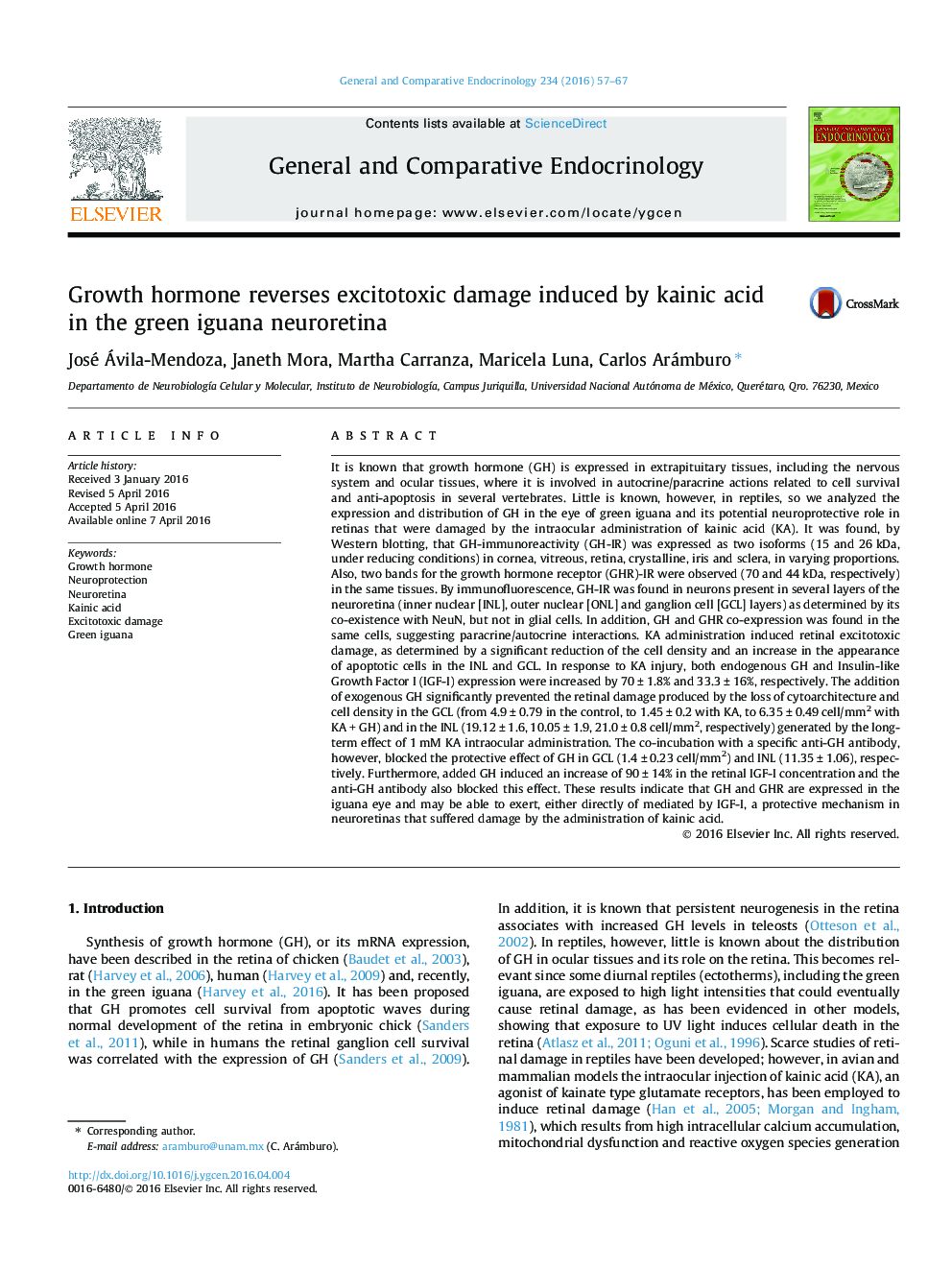| کد مقاله | کد نشریه | سال انتشار | مقاله انگلیسی | نسخه تمام متن |
|---|---|---|---|---|
| 2799787 | 1568873 | 2016 | 11 صفحه PDF | دانلود رایگان |
• GH is expressed mainly as 15 kDa isoform in the green iguana neuroretina.
• GH and GHR co-localize in retinal neural layers.
• Kainic acid induces excitotoxic damage in the neuroretina.
• Kainic acid administration increases the retinal GH and IGF-1 content.
• GH stimulates retinal IGF-1 concentration and protects cells from KA damage.
It is known that growth hormone (GH) is expressed in extrapituitary tissues, including the nervous system and ocular tissues, where it is involved in autocrine/paracrine actions related to cell survival and anti-apoptosis in several vertebrates. Little is known, however, in reptiles, so we analyzed the expression and distribution of GH in the eye of green iguana and its potential neuroprotective role in retinas that were damaged by the intraocular administration of kainic acid (KA). It was found, by Western blotting, that GH-immunoreactivity (GH-IR) was expressed as two isoforms (15 and 26 kDa, under reducing conditions) in cornea, vitreous, retina, crystalline, iris and sclera, in varying proportions. Also, two bands for the growth hormone receptor (GHR)-IR were observed (70 and 44 kDa, respectively) in the same tissues. By immunofluorescence, GH-IR was found in neurons present in several layers of the neuroretina (inner nuclear [INL], outer nuclear [ONL] and ganglion cell [GCL] layers) as determined by its co-existence with NeuN, but not in glial cells. In addition, GH and GHR co-expression was found in the same cells, suggesting paracrine/autocrine interactions. KA administration induced retinal excitotoxic damage, as determined by a significant reduction of the cell density and an increase in the appearance of apoptotic cells in the INL and GCL. In response to KA injury, both endogenous GH and Insulin-like Growth Factor I (IGF-I) expression were increased by 70 ± 1.8% and 33.3 ± 16%, respectively. The addition of exogenous GH significantly prevented the retinal damage produced by the loss of cytoarchitecture and cell density in the GCL (from 4.9 ± 0.79 in the control, to 1.45 ± 0.2 with KA, to 6.35 ± 0.49 cell/mm2 with KA + GH) and in the INL (19.12 ± 1.6, 10.05 ± 1.9, 21.0 ± 0.8 cell/mm2, respectively) generated by the long-term effect of 1 mM KA intraocular administration. The co-incubation with a specific anti-GH antibody, however, blocked the protective effect of GH in GCL (1.4 ± 0.23 cell/mm2) and INL (11.35 ± 1.06), respectively. Furthermore, added GH induced an increase of 90 ± 14% in the retinal IGF-I concentration and the anti-GH antibody also blocked this effect. These results indicate that GH and GHR are expressed in the iguana eye and may be able to exert, either directly of mediated by IGF-I, a protective mechanism in neuroretinas that suffered damage by the administration of kainic acid.
Journal: General and Comparative Endocrinology - Volume 234, 1 August 2016, Pages 57–67
